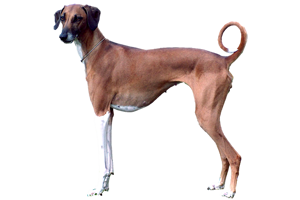Azawakh
Bareeru, Idi, Idii n' Illeli, Hanshee, Oska, Rawondu, Tuareg Sloughi, Wulo

The Azawakh is a sighthound that is kept by the Tuareg nomads in the Sahel region of Africa. There it is called the Idii n' Illeli, which translates to 'sighthound of the free people'. Its main prey are gazelle, mouflon (wild sheep), and hare. It can pursue animals at speeds nearing 40 miles per hour. They begin their training at three months of age by chasing rats before graduating to hares.
When taken on a hunt the Azawakh are carried across the saddles of camels with their masters, only released when prey is sighted. This allows them to conserve their energy as a chase may take up to five hours to complete. Unlike most sighthounds the Azawakh has been bred to hunt in packs, chasing the animal until it is too tired to continue fleeing.
As a secondary role the Azawakh is bred for protection. Guarding its owners, the encampment, and flocks from invaders such as predators and thieves. Even today it is not uncommon to see them sleeping on the straw roofs of village homes. When one dog senses danger it will jump down, alerting the others. This causes the dogs to form a pack and as a single force they will attack or drive off the predator or intruder.
The Azawakh is a sighthound that is kept by the Tuareg nomads in the Sahel region of Africa. There it is called the Idii n' Illeli, which translates to 'sighthound of the free people'. Its main prey are gazelle, mouflon (wild sheep), and hare. It can pursue animals at speeds nearing 40 miles per hour. They begin their training at three months of age by chasing rats before graduating to hares.
When taken on a hunt the Azawakh are carried across the saddles of camels with their masters, only released when prey is sighted. This allows them to conserve their energy as a chase may take up to five hours to complete. Unlike most sighthounds the Azawakh has been bred to hunt in packs, chasing the animal until it is too tired to continue fleeing.
As a secondary role the Azawakh is bred for protection. Guarding its owners, the encampment, and flocks from invaders such as predators and thieves. Even today it is not uncommon to see them sleeping on the straw roofs of village homes. When one dog senses danger it will jump down, alerting the others. This causes the dogs to form a pack and as a single force they will attack or drive off the predator or intruder.
Azawakh Standards
- 24-28"
- 45-61 lbs
- large sighthound
- ears are fine, flat and droop close to skull
- tail is long, set low and tapers toward tip
- coat is short and fine, sparse to non-existent on belly
- can be any color
History of the Azawakh
The Azawakh has existed in the arid Sahel Desert of Africa for untold centuries. Their homeland stretches through several modern countries including Mali, Niger, Burkina Faso, and Algeria. This harsh climate has ensured only the healthiest dogs survive. What weaknesses were not removed due to natural selection the Tuareg eliminated through strict culling. Often a single male was kept from a litter and occasionally a female for later reproduction to broaden the gene pool.
Among the oldest of breeds, it is impossible to know how their exact ancestry. Before DNA testing the accepted theory was that all sighthounds descended from the Middle East. All breeds sharing links through the Saluki and Afghan Hound. Under this theory the Saluki spread to the Maghreb region of Africa which developed into the Sloughi. Then in turn the Sloughi developed into the Azawakh.
With more recent testing it is now believed sighthounds developed at different times in several regions due to natural selection and the needs of their human companions. DNA evidence shows that the Azawakh is more closely related to the pariah dogs of Africa, such as the Basenji, than the Saluki. However, the Azawakh and Sloughi are one of the few breeds that share a rare glucose gene found in jackals. The only other dogs with this trait are Japanese breeds.
The Azawakh has been slow in gaining the attention of the world outside its homeland. This is partly because they were difficult to obtain. It has been said that asking for one is like asking a tribesman to sell their eldest son. But there was also little interest in them by early Europeans. When the first dogs arrived in Europe in the 1970s, there was confusion over the breed. They were seen as a variety of the Sloughi, which itself was often thought of as a smooth-coated Saluki. This misunderstanding gave them the name of Tuareg Sloughi. In 1981 the Fédération Cynologique Internationale (FCI) granted them full recognition as the Sloughi-Azawakh. The Sloughi would not be removed from their name until 1986.
Related Breeds:
